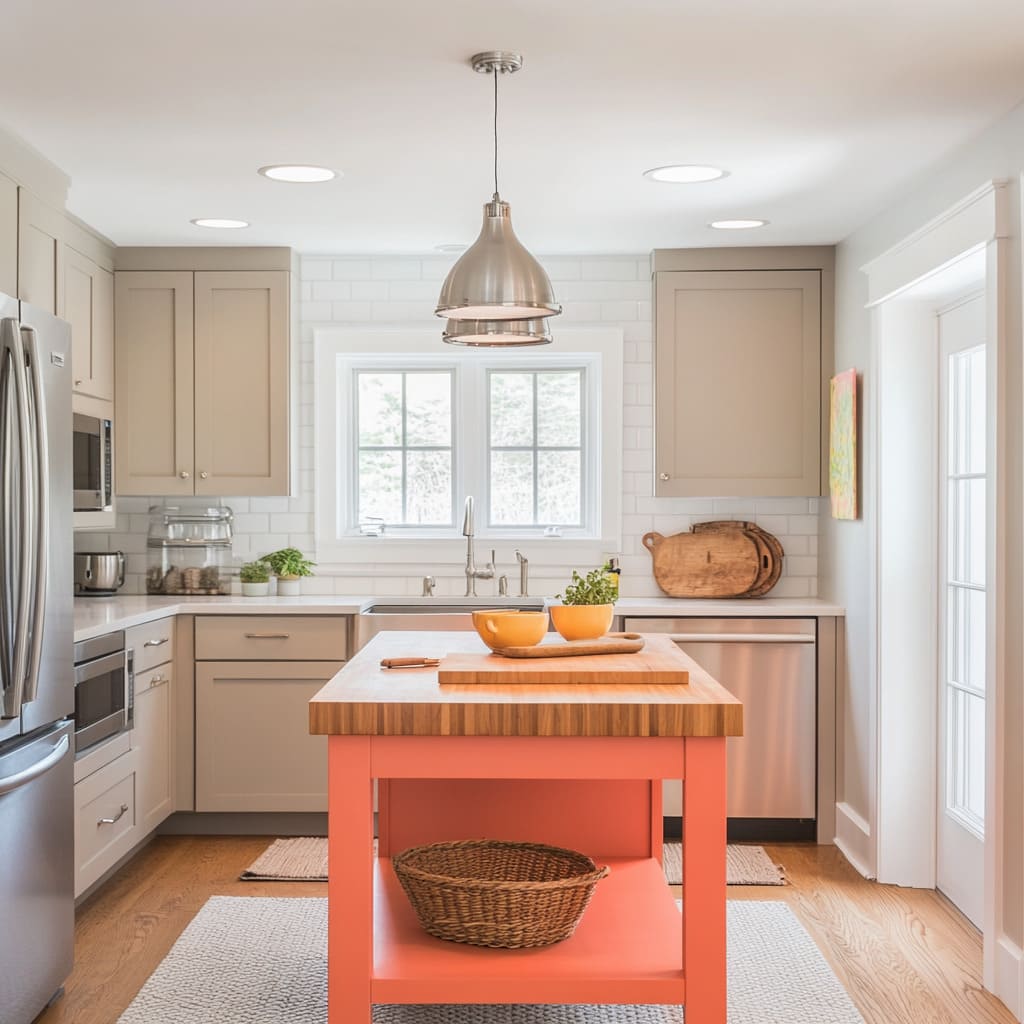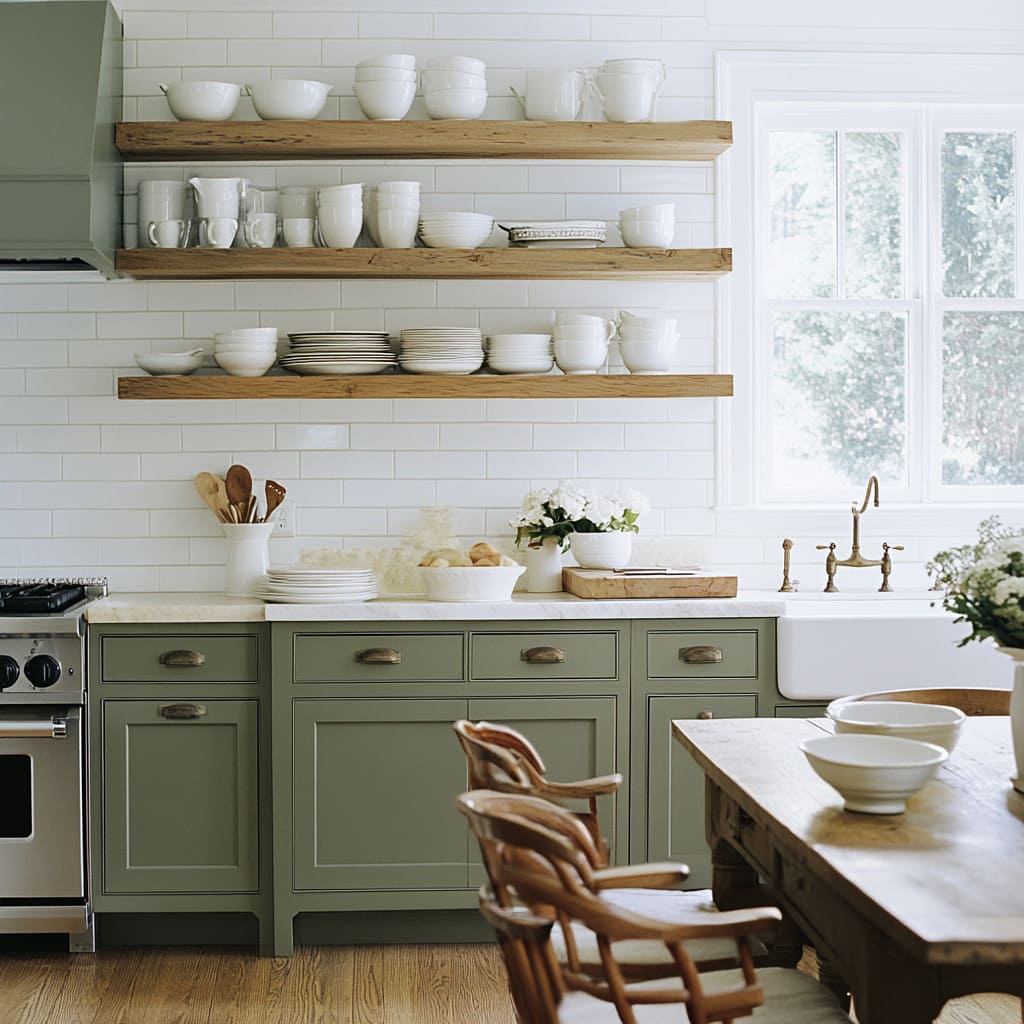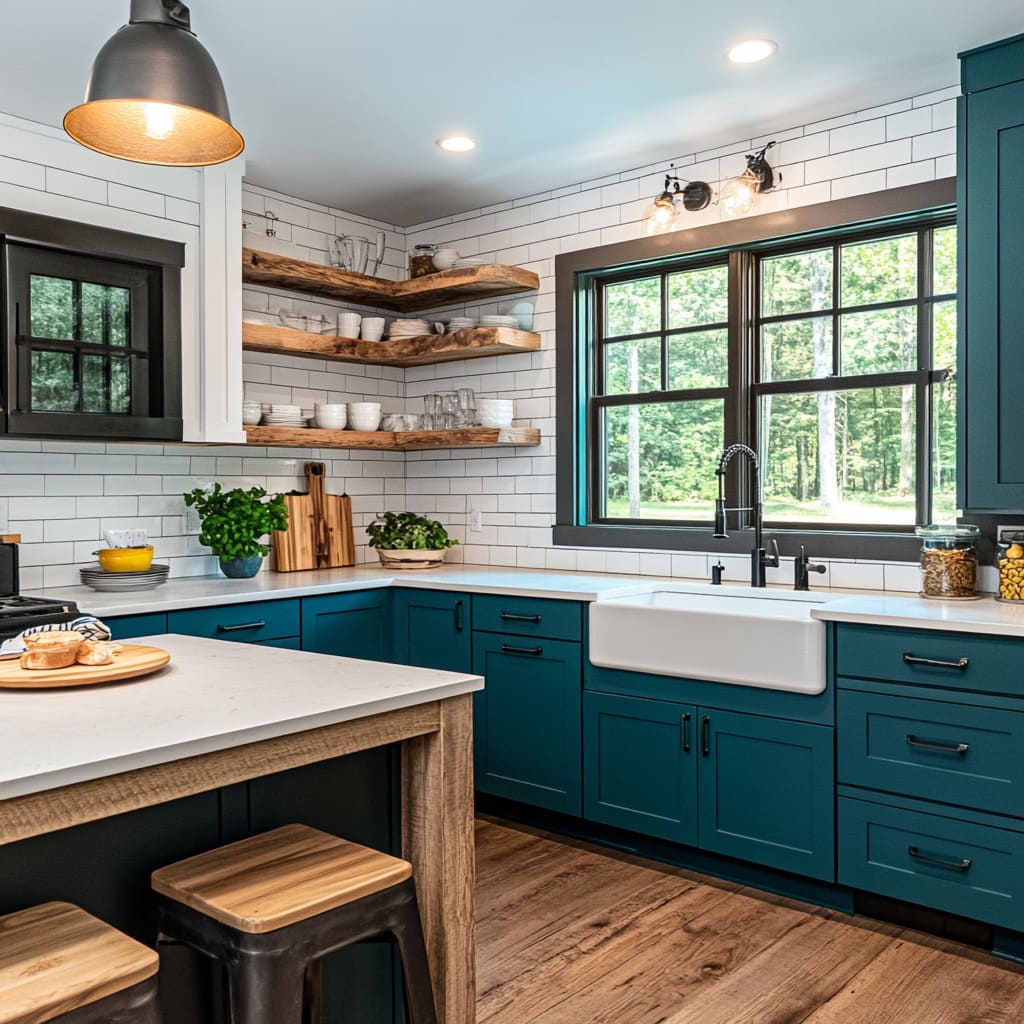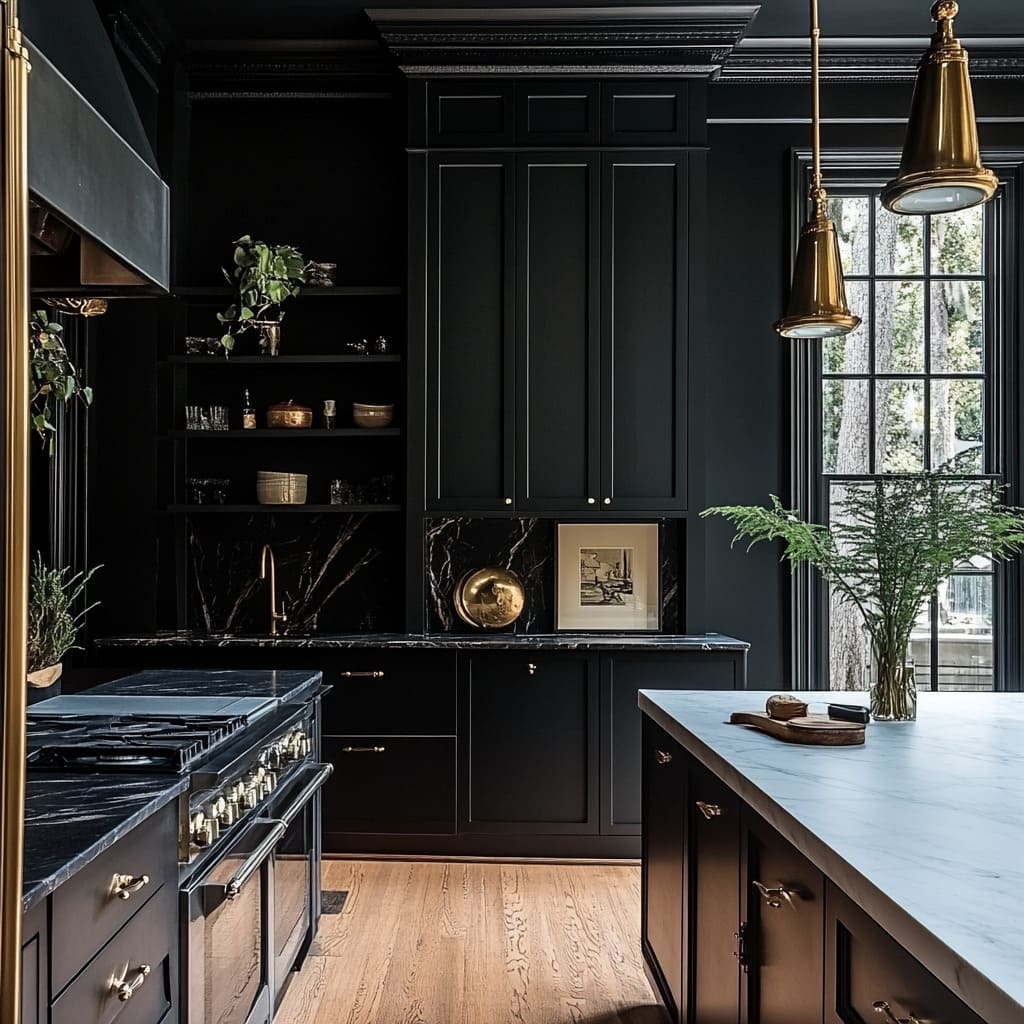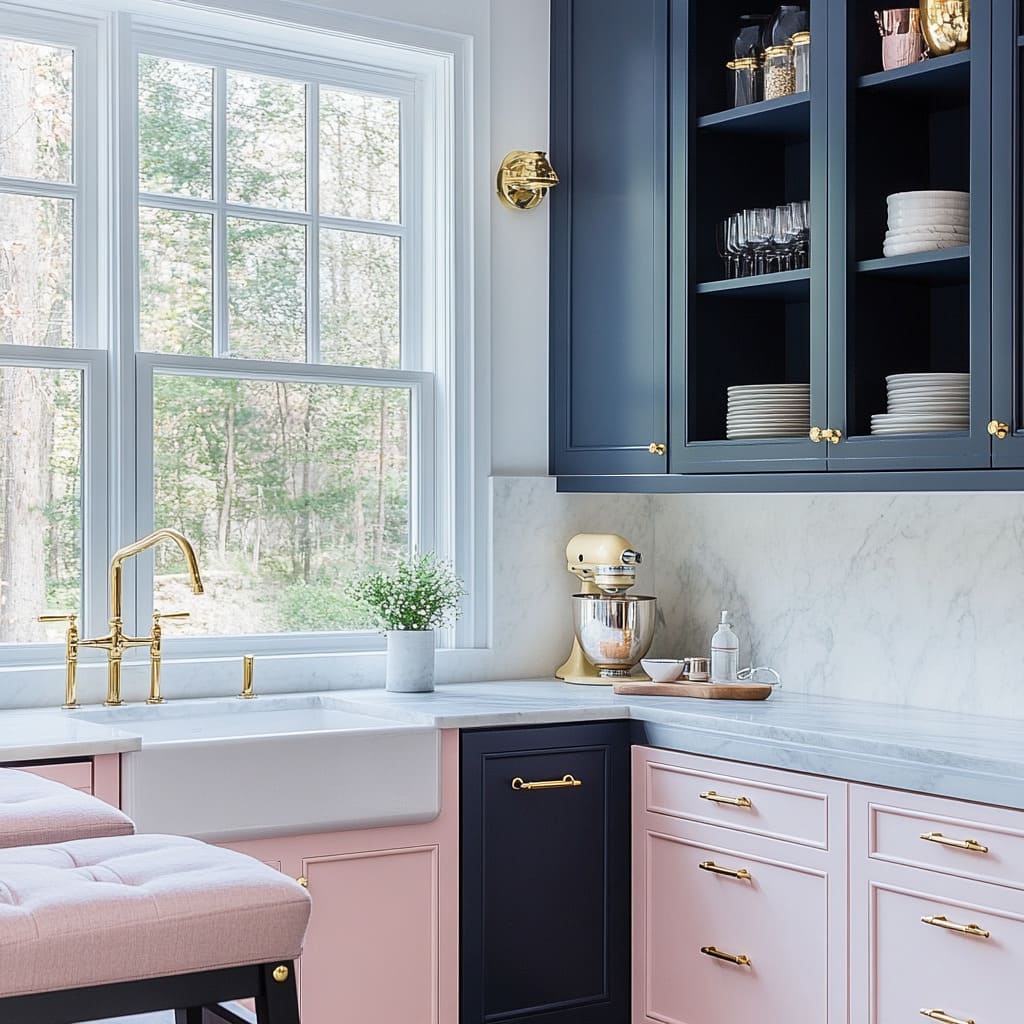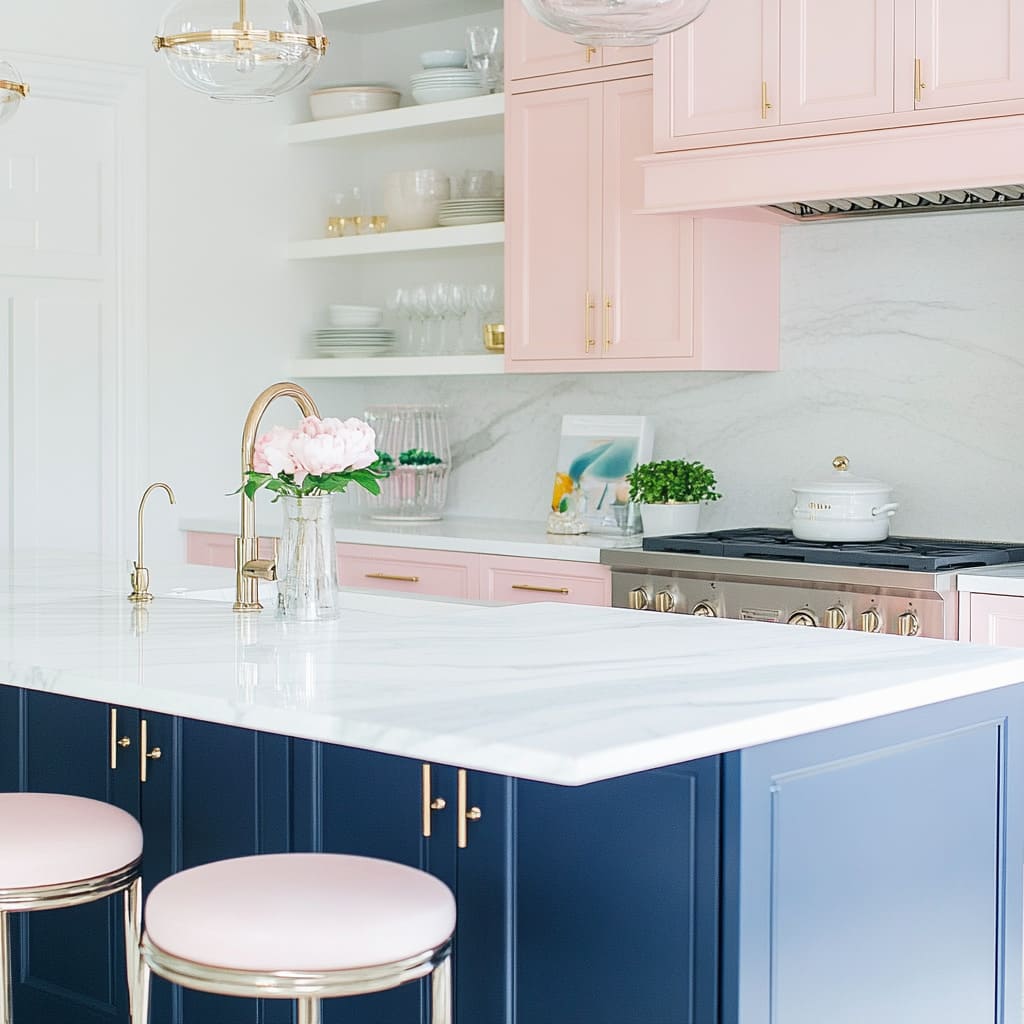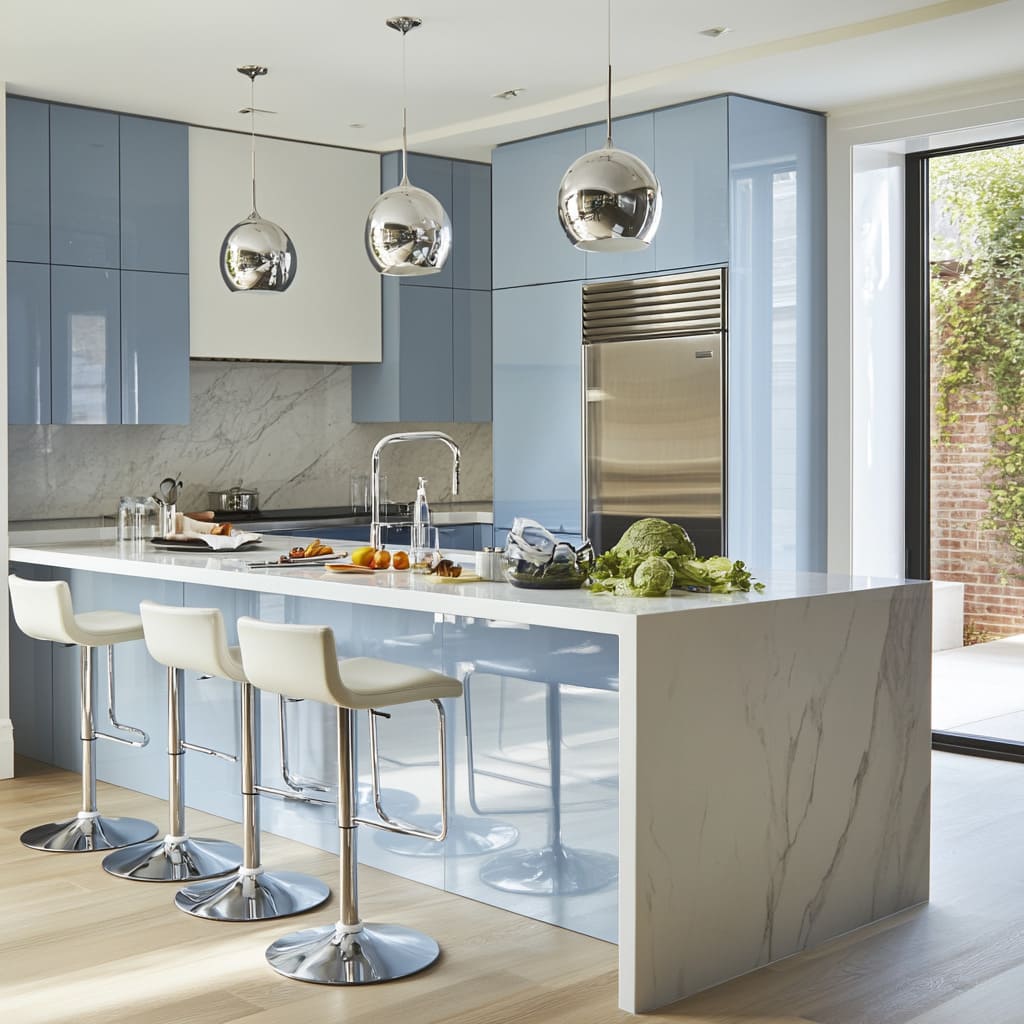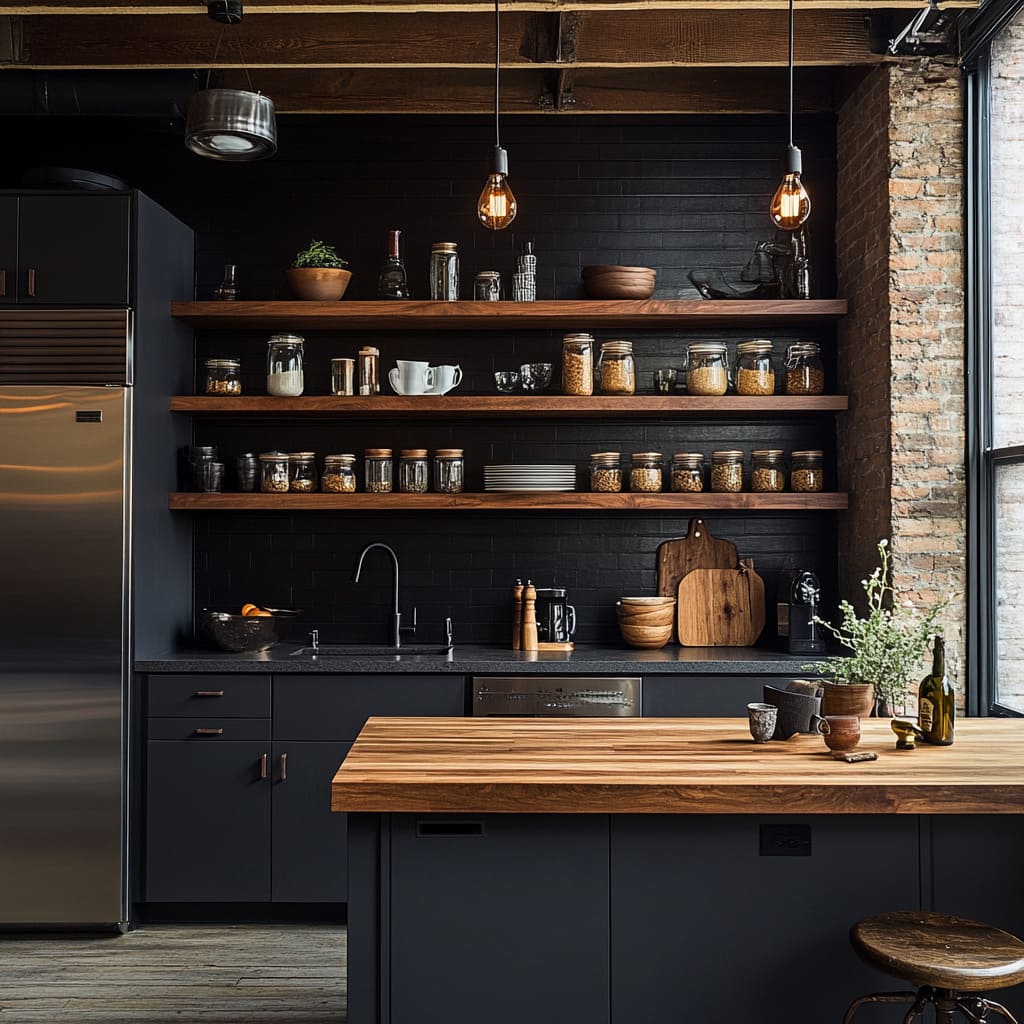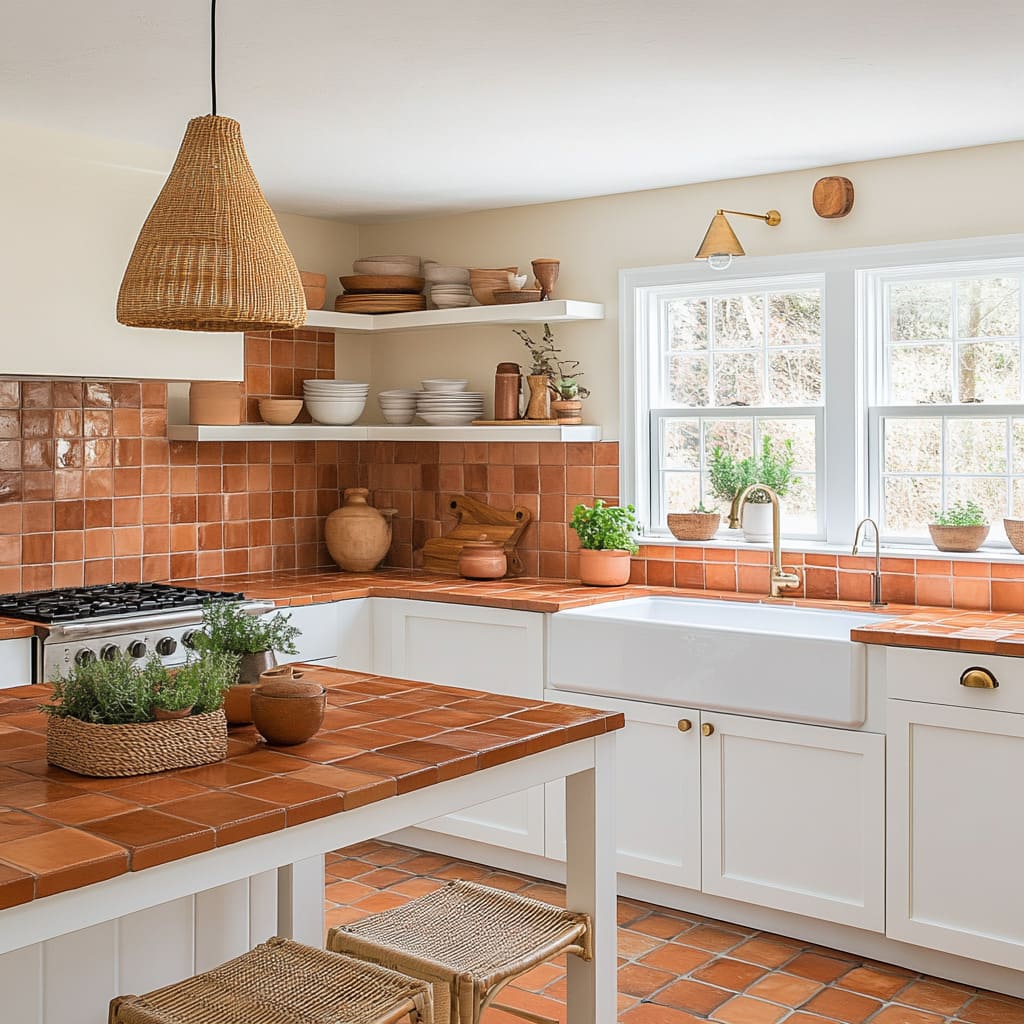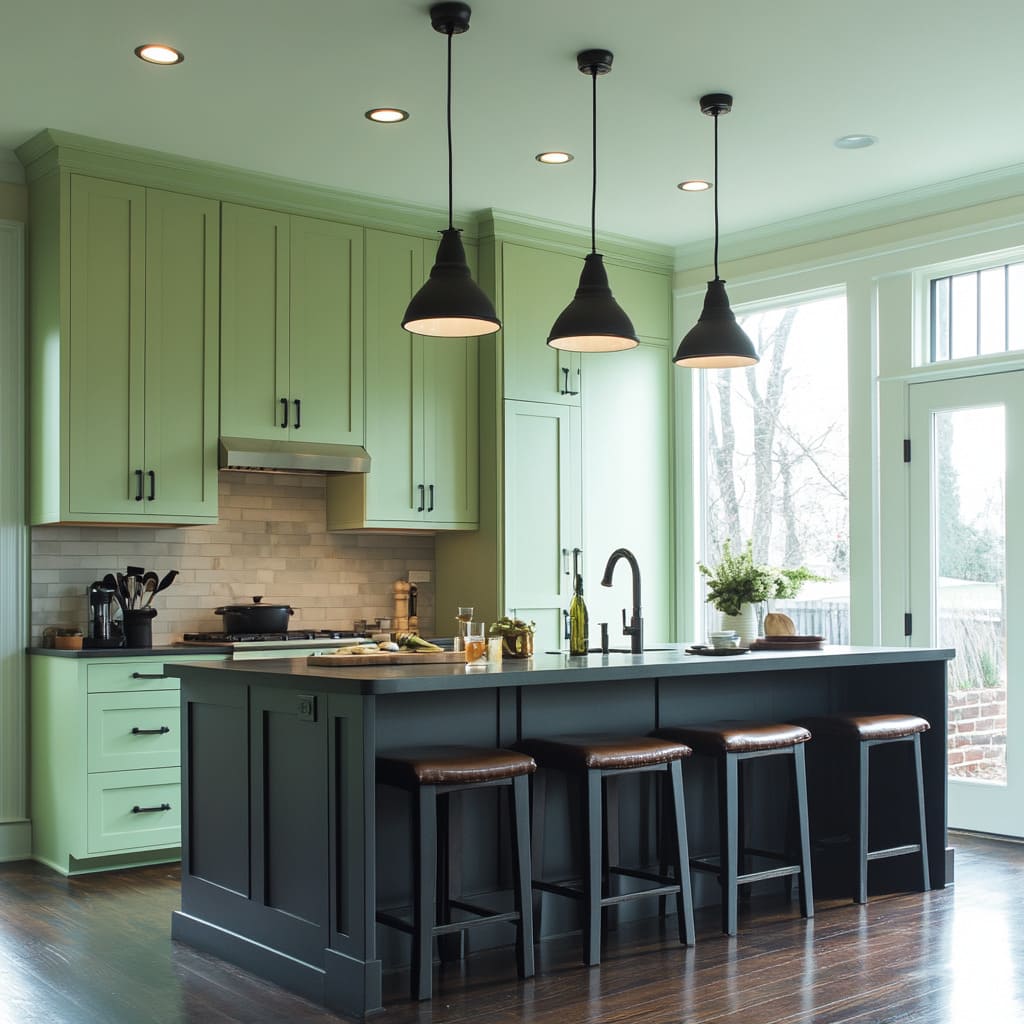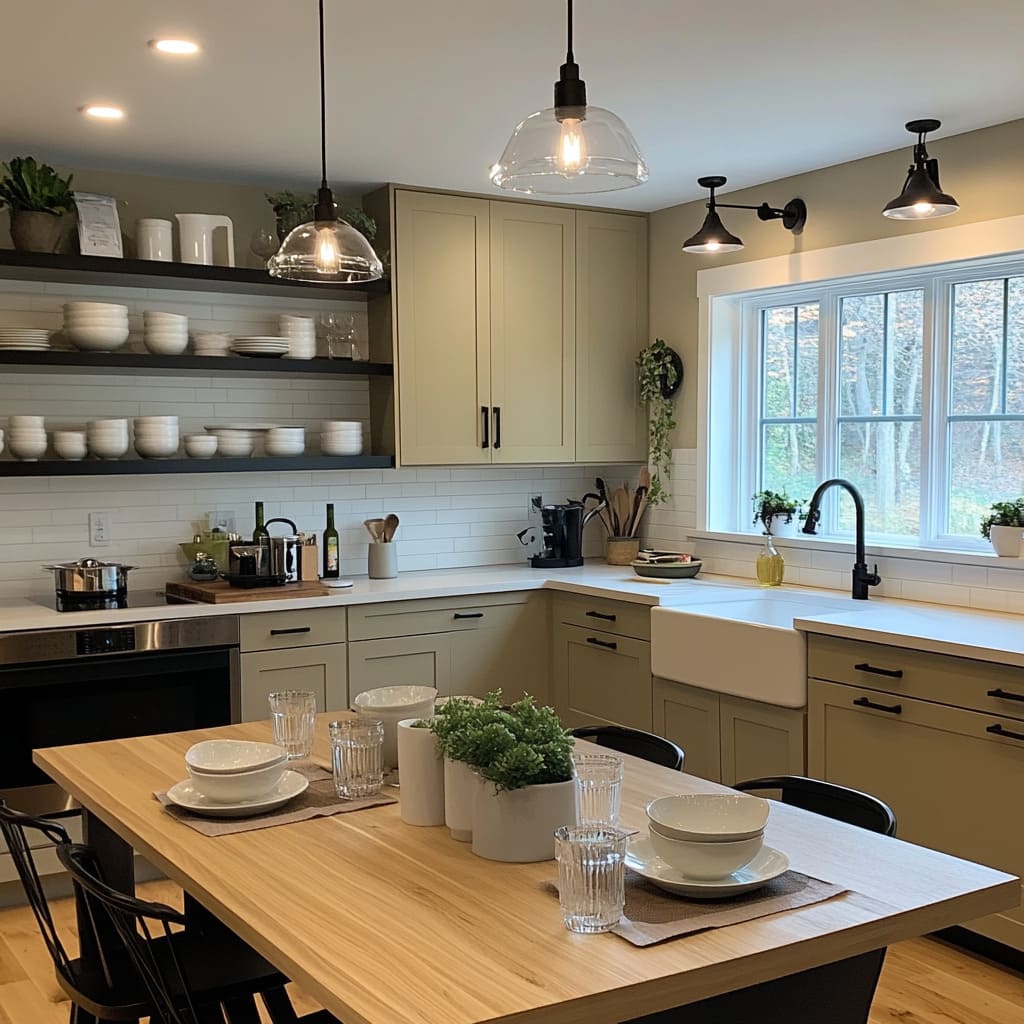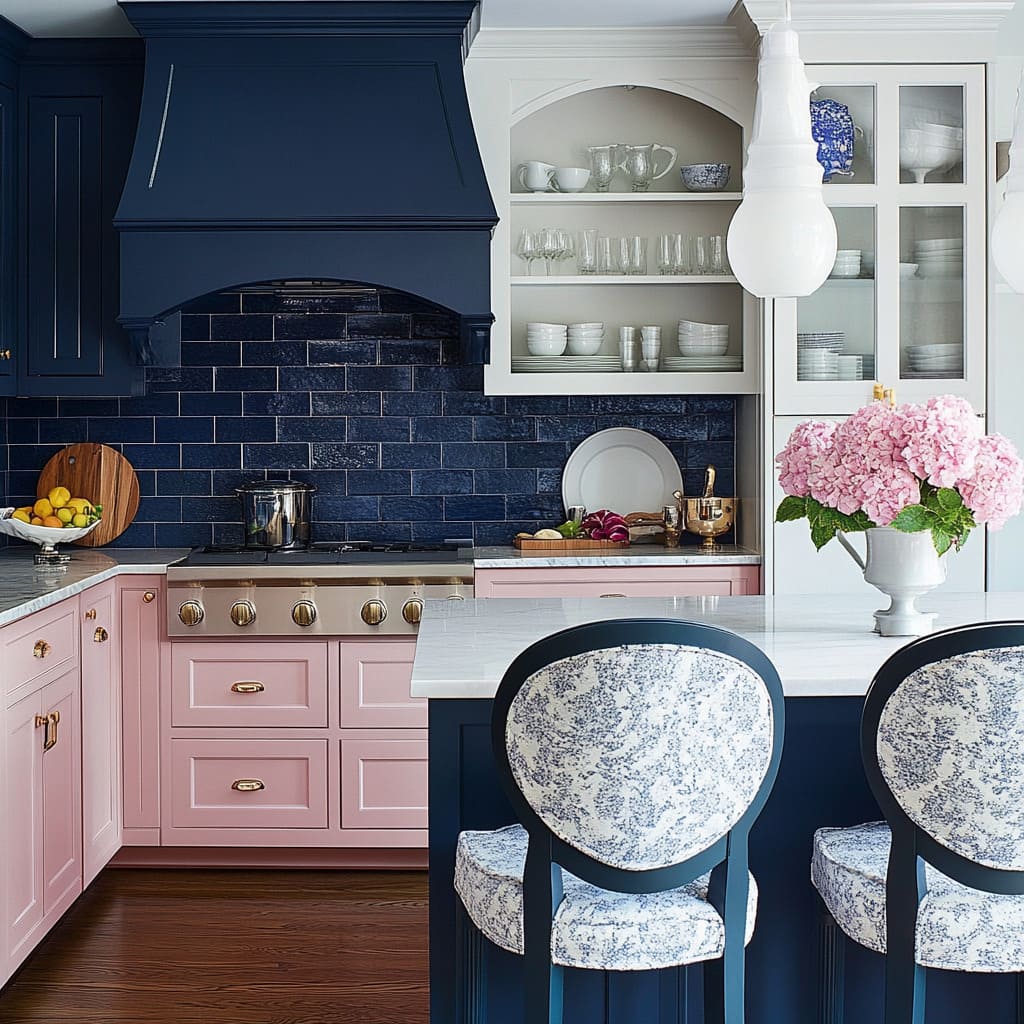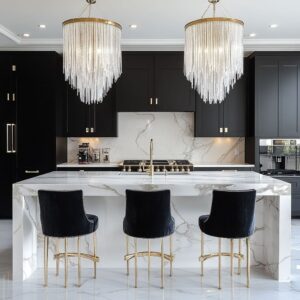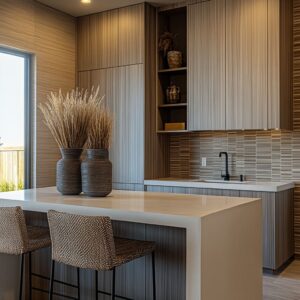Think of it like this: minimalism isn’t about making thoughtful choices; it’s about removing everything fun. So why not have fun with color while still keeping things sleek and streamlined?
The right color combinations can bring out the essence of your kitchen, making it feel both modern and inviting. Whether you’re looking for a calming retreat, a space that radiates warmth, or something that adds a pop of vibrancy without losing its understated charm, the palette you choose plays a huge role.
Sure, white will always have its place in minimalist design. It’s timeless, it reflects light like no other, and it makes even the smallest kitchens feel airy and spacious.
But what if you want to break away from the expected? What if you could keep that minimalist ethos but add a fresh twist—a little surprise that still feels intentional and composed?
That’s where exploring new color combinations comes in. From muted tones that evoke the serenity of nature to bold contrasts that make a statement, there are endless ways to mix and match colors that still feel minimalist at heart.
And here’s the best part: minimalist color palettes aren’t just about aesthetics; they’re also about creating a space that feels good to be in. The kitchen, after all, is the heart of the home—a place where meals are made, conversations happen, and memories are shared.
The colors you choose can influence the vibe of the room, from the peacefulness of soft neutrals to the energy of a bold accent wall. Let’s take a closer look at how you can keep things simple yet striking—because in a minimalist kitchen, a little color goes a long way.
Soft Sage and Crisp White
Sage green has truly captivated the design world, and it’s easy to see why! This soft, muted tone brings a sense of tranquility and sophistication to any space, making it a favorite among designers and homeowners alike.
Its subtle green hue evokes the peacefulness of nature, creating an environment that feels both calming and refreshing. One of the most striking combinations with sage green is crisp white, which provides the perfect contrast without being harsh.
If you’re thinking of incorporating sage into your kitchen, consider painting your cabinets in this soothing shade while leaving your walls white.
This allows the sage to stand out and make a statement without overwhelming the space, maintaining a clean and airy feel. For added warmth and texture, introduce natural wood elements into the design.
Wooden shelves, countertops, or even a butcher block island can add depth and a sense of organic coziness to the room. This combination of sage, white, and natural wood creates a harmonious balance that feels modern yet grounded in nature.
Charcoal Gray and Warm Wood
For a slightly bolder take, consider pairing charcoal gray cabinets with warm wood accents to create a striking yet balanced contrast. The deep, rich tones of charcoal gray bring a sense of depth and sophistication to your space, while the natural warmth of wood softens the overall look, adding a comforting organic touch.
This combination works exceptionally well for those aiming to achieve a modern, sleek aesthetic without sacrificing the inviting coziness that wood naturally offers. If you’re looking for a modern yet cozy vibe, go for a matte or semi-gloss finish on your charcoal gray cabinets—matte gives off a sleek, modern feel, while semi-gloss adds a bit of brightness.
Pair those with warm wood accents like walnut or oak to soften the look. You could use these woods in open shelving or even a butcher block countertop for contrast.
Adding textures, like wood grain backsplash or stone counters, can bring depth to the design. Don’t forget about lighting—under-cabinet lights with a warm glow can highlight the wood and make the space feel even cozier.
For hardware, think brushed brass, copper, or blackened bronze, which will bring a touch of elegance. To keep the space from feeling too dark, balance it out with lighter elements like a pale countertop or letting in lots of natural light.
Dusty Blue and Cream
Dusty blue is a timeless and versatile color that effortlessly infuses a sense of calm and tranquility into any space. Its soft, muted tone makes it ideal for creating an environment that feels both relaxed and sophisticated.
When paired with creamy whites or soft beiges, dusty blue offers a cozy yet chic aesthetic that feels warm without being overpowering. In a kitchen setting, this combination can be transformative.
Consider using dusty blue for your kitchen island to create a stunning focal point, while opting for cream or off-white cabinets to maintain a light, airy feel. This contrast not only adds visual interest but also makes the space feel open and welcoming, a perfect balance for a room meant to gather friends and family.
For those who prefer a more subtle approach, an accent wall in dusty blue can add depth to the space without overwhelming it.
Bold Black and Brass
If you’re feeling adventurous in your kitchen design, why not consider going bold with black cabinets? This striking color choice not only makes a dramatic statement but also exudes modern sophistication.
Black cabinets can create a sleek and contemporary backdrop that enhances the overall aesthetic of your kitchen. To create a sophisticated look with black cabinets, opt for a matte or satin finish to avoid excessive light reflection and maintenance issues associated with glossy surfaces.
Pair these cabinets with brass accents in light fixtures, hardware, and faucets for a luxurious contrast that adds warmth. Incorporating natural elements like wood or stone can soften the overall aesthetic and introduce texture.
Bright colors in decor—such as vibrant rugs or statement art—can infuse personality into the space. Open shelving allows for the display of decorative items without overwhelming the design, while strategic lighting can enhance the inviting atmosphere.
Lastly, maintain a minimalist approach by keeping countertops uncluttered and limiting decorative pieces to let the black cabinets and brass accents shine.
Earthy Terracotta and Soft White
If you’re a fan of earthy tones, you really can’t go wrong with terracotta. It’s such a warm, muted orange that instantly brings a cozy vibe and a touch of natural beauty to any space.
Just think of those sun-soaked landscapes—terracotta captures that essence perfectly! Its rich, organic feel makes it incredibly versatile, and it pairs so well with soft whites.
This combination creates a balanced and harmonious look that feels inviting and grounded. It’s a great way to make your space feel like a warm hug!
This warm, muted orange hue evokes sun-soaked landscapes, creating a cozy atmosphere while offering versatility in design. To incorporate terracotta in your kitchen, consider using it for backsplashes or cabinets, pairing it with white countertops for a clean and sophisticated look.
Enhance the earthy vibe by adding natural materials like wooden utensils and ceramic dishware, and opt for warm lighting fixtures to create an inviting ambiance. Introducing accent colors inspired by nature and incorporating textiles in complementary tones can further tie the design together.
Finally, showcase terracotta dishware on open shelving to add a personal touch and warmth to your kitchen.
Cool Mint and Charcoal
Mint green is such a refreshing color that brings a modern touch to a minimalist kitchen! Its soft, soothing shade creates a calm and clean vibe, making it the perfect backdrop for a space where you cook and gather with friends and family.
And when you pair mint green with charcoal accents, you get this stunning contrast that takes the look to a whole new level. It makes your kitchen feel both contemporary and inviting—it’s a combo that’s sure to impress!
When it comes to designing your kitchen, consider using mint green for your cabinetry—it can be a full set or just an accent to add a pop of color. If you’re feeling bold, pair it with a charcoal island for a stunning focal point.
Not ready to go all in? No worries!
You could paint an accent wall in mint green for a fresh vibe. Make sure to choose countertops in white or light gray to tie the colors together and keep the space feeling light and airy.
You can also add mint green through smaller decor items like dishware or kitchen towels, which are easy to swap out for a seasonal refresh. For lighting, opt for matte black fixtures to enhance those charcoal accents.
Mixing materials can add depth, so think about pairing matte mint cabinets with a glossy charcoal island. Don’t forget to include natural wood elements to warm up the space, and if you have room, open shelving in mint green can showcase your favorite dishes beautifully!
Soft Blush and Deep Navy
Blush pink might not be the first color that comes to mind for a kitchen, but when paired with deep navy, it creates a stunning blend of softness and boldness. Imagine using blush for your lower cabinets and deep navy for the upper ones; this combination draws the eye upward, making your kitchen feel more spacious and inviting.
Alternatively, if you prefer to keep cabinetry simple with navy, introducing blush through decor—like textiles or small appliances—can add a lovely touch of warmth without overwhelming the space. When designing with these colors, it’s all about balance and contrast.
You can mix and match materials, too! Think about pairing matte blush cabinets with shiny navy hardware for a chic look or introducing natural elements like wooden accents to soften the overall vibe.
Lighting plays a significant role as well; consider brass or gold fixtures that can beautifully tie together both hues while adding a touch of elegance. Finally, don’t forget about your decor!
Adding blush through cushions, rugs, or even artwork can create a cohesive feel. Open shelving is another great way to showcase both colors while keeping your space functional and stylish.
With a little creativity, this blush and navy palette can transform your kitchen into a stylish and modern haven that reflects your taste.
Warm Beige and Olive Green
Warm beige is a fantastic choice for your kitchen’s backdrop, creating a cozy and inviting atmosphere. This neutral color sets the stage for a refined space that feels both sophisticated and comforting.
Pairing it with olive green introduces an earthy element that brings a touch of nature indoors, making the kitchen feel alive and vibrant. To achieve a chic look, consider using warm beige for your cabinetry.
This choice will provide a solid foundation while allowing olive green accents to pop, whether you use them for open shelving, an island, or even a statement wall. Textiles in olive green, like curtains or table linens, can further enhance the color scheme and add layers of warmth and comfort.
Don’t forget about the finishing touches! Incorporating natural elements like wooden utensils, ceramic dishes, or potted herbs can tie the whole look together and emphasize the earthy vibe.
Choosing warm lighting fixtures will create a welcoming ambiance, making your kitchen the perfect spot for both cooking and entertaining. With these thoughtful design tips, you can create a beautiful kitchen that feels like a serene retreat.
Muted Coral and Light Gray
Coral is such a fun color—it’s like the life of the party for your minimalist kitchen! Its vibrant and warm vibe can instantly lift the mood without taking over the whole space.
Imagine painting an accent wall in coral or giving your kitchen island a splash of this cheerful hue. Pairing it with light gray is a game-changer, creating a soft and inviting atmosphere that’s perfect for cooking up a storm or just hanging out with friends.
Now, picture walking into your kitchen and being greeted by that gorgeous coral wall! It’s a total showstopper, right?
Or how about using coral for your cabinetry or island? It adds a playful punch while keeping things grounded with those soothing gray tones.
The key is to strike a balance—make it lively but still sophisticated. That way, your kitchen feels like a bright, cheerful space where you want to spend your time.
To let coral shine, consider bringing in some natural materials, like warm wood or cool stone, to offset the color’s vibrancy. Mixing in textured elements can add depth and interest, and small coral accents—like dishware or kitchen linens—are a great way to play with this color without going all out.
If you’re feeling bold, throw in some fun patterns too! With a little creativity, you can turn your kitchen into a lively and inviting space that feels uniquely you.
Deep Teal and White
You know, deep teal is such a fantastic pick for a minimalist kitchen! It brings in that splash of drama while still keeping things elegant and refined.
This rich color can set the mood, making your space feel tranquil and inviting—kind of like being near the ocean. Pairing it with bright white accents transforms the whole vibe into something fresh and classic.
That contrast just allows the teal to pop, while still keeping the overall look light and airy. One of the coolest ways to showcase deep teal is through your cabinets.
Imagine having those gorgeous teal cabinets as the star of your kitchen! They draw the eye and create an awesome focal point, making a simple kitchen feel anything but ordinary.
Plus, mixing textures can elevate the design—picture matte teal cabinets paired with glossy white countertops or a beautifully textured backsplash. It adds layers of interest that keep your kitchen looking dynamic and inviting.
And let’s talk about lighting and accessories because they can make a difference! A mix of task and ambient lighting can highlight those stunning teal tones while creating a cozy atmosphere.
Throw in some natural materials, like a warm wooden dining table or a stone countertop, and you’ve got a grounded, inviting space. Finally, don’t shy away from fun accessories that play off the teal; just a few well-chosen pieces can tie everything together without cluttering the minimalist feel.
Mastering Color Combinations in a Minimalist Kitchen
When it comes to designing a minimalist kitchen, color is a powerful tool that can elevate the space from bland to beautifully cohesive. While the minimalist aesthetic often leans towards whites and neutrals, adding color can create depth, warmth, and personality without compromising that clean look.
Here are some friendly tips for combining colors in your minimalist kitchen, ensuring you achieve a stylish and harmonious environment.
Start with a Neutral Base
Think of your kitchen as a blank canvas. Starting with a neutral base—whites, creams, soft greys, or beiges—creates a calming backdrop that allows you to play with color without overwhelming the space.
This foundation gives you the freedom to introduce bold or subtle hues in a way that feels effortless. For instance, if you choose a warm beige for your walls, you can easily incorporate cool-toned accents like navy blue or forest green in your cabinetry or accessories.
The key is to keep the foundational colors light and airy, allowing the accent colors to pop.
Choose a Color Palette
Before you dive into painting and purchasing, take a moment to define your color palette. This doesn’t mean you have to stick to just two colors!
A palette can consist of three to five colors that work harmoniously together. For example, a palette of soft grey, dusty pink, and crisp white can create a chic, sophisticated vibe.
If you’re feeling bold, consider adding a deep teal or mustard yellow as an accent. Tools like color wheel apps or online resources can help you visualize combinations and understand which colors complement each other.
Balance Light and Dark Tones
Creating a balanced look is crucial in a minimalist kitchen. Pairing light and dark tones can add depth and dimension to your space.
If you have light-colored cabinets, consider contrasting them with a dark island or a charcoal backsplash. This not only creates visual interest but also helps to define different areas within the kitchen.
A good rule of thumb is to use about 60% of your dominant color (often light), 30% of your secondary color (darker), and 10% for accents. This ratio helps maintain that minimalist feel while still allowing for color diversity.
Incorporate Texture with Color
One of the joys of a minimalist kitchen is the emphasis on materials and textures. Don’t be afraid to combine colors through various textures!
For example, matte paint finishes can soften bold colors, while glossy surfaces can reflect light and make colors appear more vibrant. Consider mixing a matte black countertop with glossy white cabinets or textured terracotta tiles with soft green walls.
The contrast in textures can enhance the visual appeal of the colors you choose, making the space feel layered and inviting.
Use Color to Define Zones
If your kitchen has an open floor plan, color can help define different zones or areas. For instance, you could paint the kitchen island a bold color, like a deep navy, while keeping the rest of the cabinetry a softer white or grey.
This helps draw attention to the island as a functional focal point while maintaining a cohesive look throughout the space. Another way to do this is through backsplash tiles—opt for a striking pattern or a solid color that contrasts with the cabinetry.
This not only creates a visual break but also adds character to the kitchen without going overboard.
Accent Wisely
Accent colors are your best friends in a minimalist kitchen! Whether through dishware, appliances, or decorative elements, these pops of color can bring personality to your space.
Instead of overwhelming the kitchen with bright colors, use them sparingly to draw attention to specific features. Think about using colorful bar stools on your island or vibrant dishware displayed on open shelves.
A few well-placed colorful accessories can make a significant impact without detracting from the minimalist aesthetic.
Test Before You Commit
Finally, never underestimate the importance of testing your colors! Lighting plays a huge role in how colors appear, so it’s wise to sample paint or materials in your kitchen’s lighting conditions.
A color that looks fantastic in a swatch may feel entirely different when applied to your walls or cabinets. Take the time to paint a small area or use large sample boards to see how colors interact with each other throughout the day.
This simple step can save you from any color regrets later on!
Key Takeaway
As you contemplate your kitchen’s transformation, remember that color has the power to evoke emotions, create atmospheres, and tell a story. It’s not just about aesthetics; it’s about crafting a space where memories are made, meals are shared, and creativity flourishes.
Stepping away from the conventional white allows you to express your unique style and vibrantly embrace the nuances of minimalism. So, why not explore these chic palettes and see which one resonates with you?
Your kitchen can be more than just a place to prepare food; it can be a canvas for your creativity and a sanctuary for your senses. Dive into this journey of color and design, and let your kitchen be a reflection of the vibrant life you lead!
After all, the best kitchens are the ones that inspire us to create, connect, and savor every moment.


